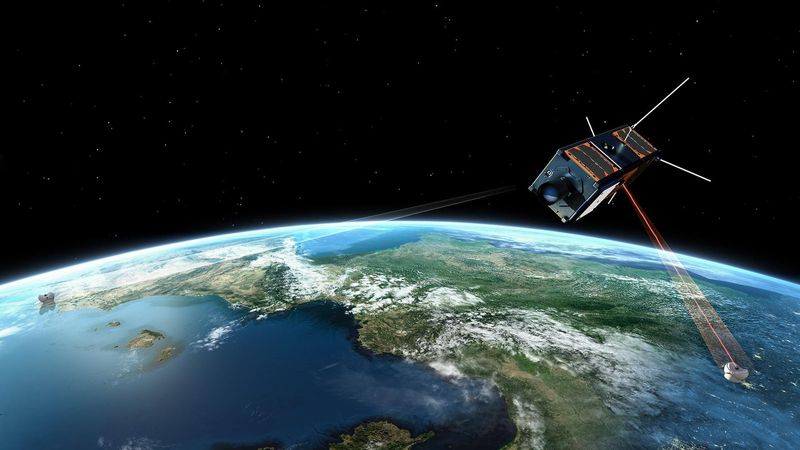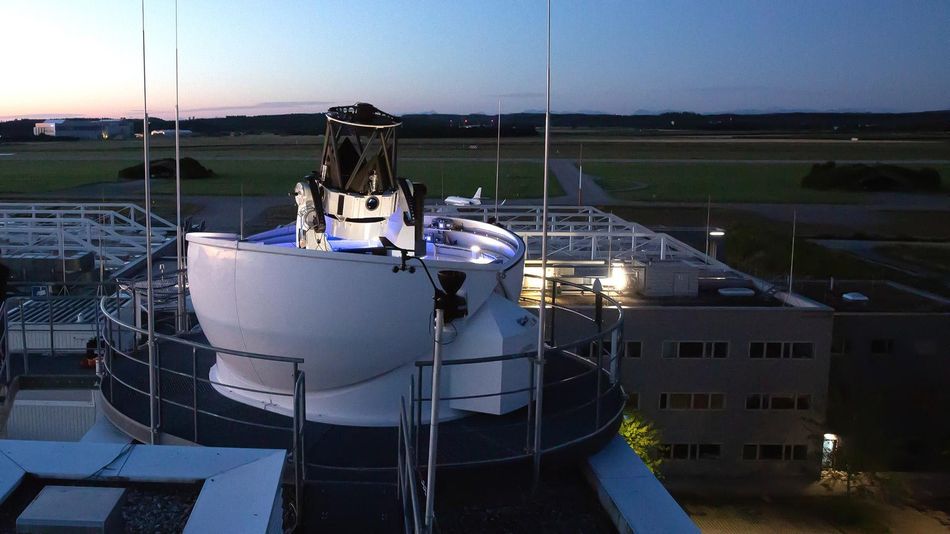Demonstration of data transmission from a microsatellite by laser
Small satellites are becoming increasingly compact and powerful. The technology of conventional radio channels is reaching its limits due to the rising number of satellites.

The PIXL-1 small satellite can acquire images of the Earth with a high-resolution camera and send them to the Optical Ground Station Oberpfaffenhofen with the CubeLCT via a laser link. Credit: DLR (CC BY-NC-ND 3.0)
This article was first published on
www.dlr.deSmall satellites are becoming increasingly compact and powerful. The technology of conventional radio channels is reaching its limits due to the rising number of satellites. Laser communications offers solutions for the efficient transmission of high data volumes without interfering with other channels. For this application, the German Aerospace Center (Deutsches Zentrum für Luft- und Raumfahrt; DLR) Institute of Communications and Navigation, together with the company Tesat-Spacecom GmbH & Co. KG TESAT, developed OSIRIS4CubeSat, the world's smallest commercially available laser communications terminal. The reliability and error-free functionality of the terminal, which was specifically developed for use on microsatellites, was confirmed during a test mission in space.
"This success is the result of our many years of research in the field of optical satellite communications," says Florian David, Director of the DLR Institute of Communications and Navigation. "It demonstrates the impressive potential for designing small, light and at the same time powerful optical satellite terminals. This is an important building block for future satellite systems, for example for Earth observation or in megaconstellations."
Microsatellite with an optical communications system
The first OSIRIS4CubeSat terminal was launched into space on board the CubeL satellite on 24 January 2021. During the PIXL-1 mission, images acquired by the camera system on CubeL could be sent to the Optical Ground Station Oberpfaffenhofen using the OSIRIS4CubeSat laser. Both the satellite and the laser terminal have since undergone extensive testing. Now the tests have been successfully completed with an end-to-end demonstration. The reliability and error-free functionality of OSIRIS4CubeSat in space have been confirmed.
Microsatellites, or CubeSats, have a standardised cube shape with an edge length of 10 centimetres and can be extended as required. The laser communications terminal developed in the OSIRIS4CubeSat project together with TESAT complies with this standard. The patented design, in which an electronic circuit board was used as the mechanical basis for the optical elements for the first time, made it possible to achieve a high degree of compactness.
High data transmission rates without electromagnetic interference
With a data rate of 100 megabits per second, the laser terminal's speed far surpasses the transmission capabilities of comparable radio systems. In addition to the high data rate, laser light as a transmission medium is unaffected by electromagnetic interference. Channel crosstalk, as often occurs with conventional radio channels, does not exist with laser transmission. This means that laser transmission channels do not require lengthy approval procedures on the part of the Federal Network Agency (Bundesnetzagentur; BNetzA) or the International Telecommunication Union (ITU).
When transmitting image data to Earth by laser, encoding procedures developed at DLR were employed to safeguard the data. This is necessary to maintain stable, zero-loss transmission from the satellite to Earth, since the data must be protected from disruptions caused by atmospheric effects. For this purpose, they are encoded on the satellite before being sent to the ground station using the laser link. There, following reception, they are decoded and then processed. The German Space Operations Center (GSOC) is responsible for the commanding, operation and support of the satellite. CubeL is thus the first CubeSat to be successfully integrated into GSOC's existing ground segment.
From research to industrial application
The results from PIXL-1 show the error-free functionality of the OSIRIS4CubeSat terminal along the complete transmission chain. This will enable widespread use of laser communications on a large number of satellites in the future. The technology was transferred to TESAT even before the demonstration mission was completed. TESAT has since incorporated the terminal into its portfolio and offers it to commercial customers under the name 'CubeLCT' or 'SCOT20', which is a further development of the product.
Siegbert Martin, Chief Technology Officer at TESAT said: "This underlines the great opportunities that arise from cooperation between research and industry in Germany."

